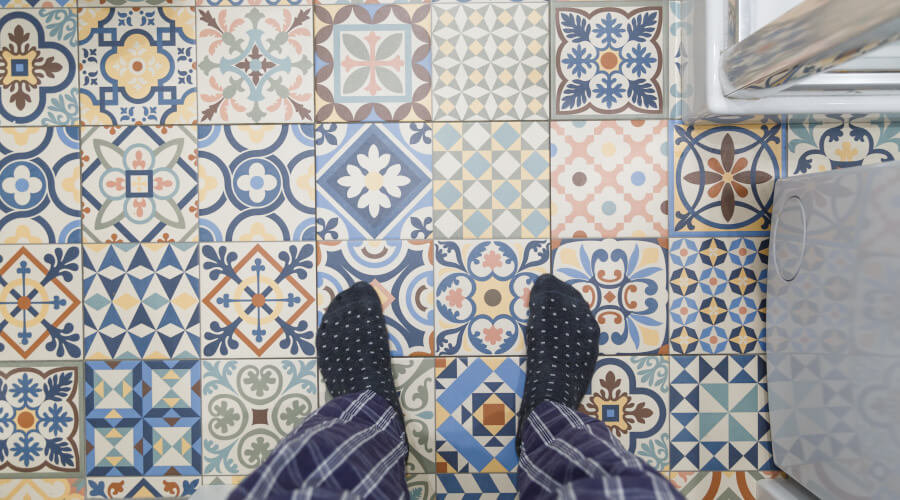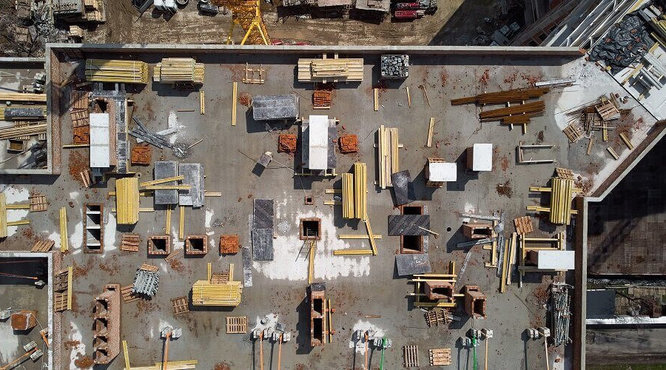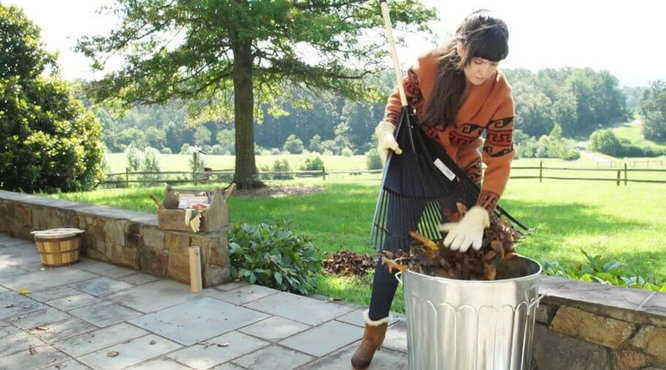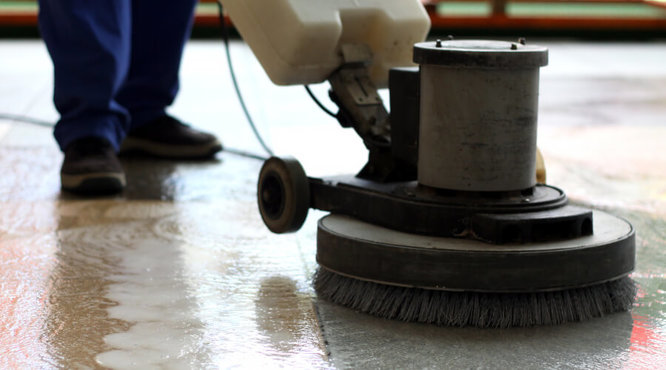Laying a high quality tiled floor in your kitchen or bathroom is a great way of giving your home that modern, chic, beautiful finish. There is a huge range of floor tiling options out there for you - natural stone, slate, porcelain and ceramic tiles are all available in a huge range of colours, textures and sizes. So whatever your style, you will be able to find the right tiles for your home! And with the right tools and know-how, it’s not too difficult to lay your tiled floor yourself.
You Will Need
- Your choice of floor tiles
- Tile adhesive
- Manual tile cutter – suitable for ceramic tiles and most porcelain tiles.
The manual tile cutter is suitable for ceramic tiles and most porcelain tiles, as these are generally smaller, easy to cut tiles. The manual tile cutter is easy to use and is capable of splitting tiles into straight pieces only.
- Electric tile cutter / diamond tile cutter – suitable for natural stone tiles and cutting corners & curves
Electric tile cutters, or diamond tile cutters, are more suitable for natural stone tiles, as these are larger and tougher. These cutters can also be used for cutting curves and corners in tiles, so they are ideal for use when laying bathroom tiles, as you may need to fit the tiles around sinks and toilets.
- Protective equipment – Knee pads, protective gloves, protective goggles and a dust mask
- Spirit level
- Tape measure
- A damp proof coarse or waterproof primer
- Roller and a tray – for applying the primer
- Tile marker / chalk
- Bucket
- Power stirrer / mixing paddle
- Small trowel & a notched trowel for spreading tiling adhesive
- Tile grout
- Grouting sponge
- Grout profiling tool
- Timber baton
Safety points to consider
You should wear knee pad protection whilst working on the floor, as you will spend a lot of time kneeling on the cold, hard concrete floor, and this can become uncomfortable quite quickly. You should also wear a dust mask and eye protection goggles whilst cutting tiles, to protect yourself from the dust created during cutting. You should wear heavy duty gloves whilst handling the tiles, as edges can be sharp; and whilst you are mixing and laying the adhesive – as this can cause skin irritation.
Some tiles, such as natural stone, can be very heavy. Ensure that you lift them correctly, using your legs rather than your back. Also try to ensure that you don’t try to lift too much at once.
Preparing the floor for tiling
If you are tiling a bathroom floor and have toilet and sink fittings which may get in the way, it is possible to tile around these, however it makes the job much simpler if you uninstall these, rather than trying to shape tiles around them. As, this can get messy and untidy quite easily.
If you are laying tiles on to an untreated concrete floor, you will need to spread a waterproof primer over it, to prevent moisture from becoming trapped in the concrete.
You must also ensure that the concrete floor is level, before you begin tiling the floor. To do this, you can lay a long wooden concrete baton along the floor, and look out for areas where there are large gaps between the floor and the bottom of the baton. If there are any obvious gaps greater than 3mm, you will need to level the floor using a self-levelling compound. You can mix the compound using a bucket and power stirrer – simply follow the manufacturer’s instructions to determine the correct water to compound ratio. Once you have mixed the compound, simply spread the compound over the concrete floor using a trowel. This can take a couple of hours to dry, but once it has dried you will have a perfectly flat and smooth surface ready for tiling.
If your floor consists of wooden floorboards, you should not tile straight on to those. Rather, you should lay down plywood slabs, prime the plywood and lay the tiles on to the plywood using a flexible adhesive.
Applying tile adhesive
Firstly, you will need to mix up the tile adhesive. Read the instructions on the bag of adhesive you have bought to determine the correct amount of powder to water and pour this into a bucket. You can use a power stirrer with a mixing paddle to mix the adhesive to the correct consistency – it should be quite a thick, gloopy consistency. Remember, the type of adhesive that you need depends on the type of surface that you’re tiling and the type of tiles that you are using – so check the manufacturer’s instructions and ask your supplier for help if needed.
Start in the centre of the room and, using a small trowel, apply a small lump of adhesive to the floor – enough for just a couple of tiles. Then use the notched trowel to spread the adhesive evenly over the area of the floor. The design of the notched trowel will create a solid bed for the floor tiles to sit on, removing excess amounts of adhesive and creating a consistent level of adhesive for the tiles to sit on. You will know if the correct amount of adhesive has been applied to the floor, as when you spread the adhesive over the floor using the notched trowel, you will hear a scraping sound of the trowel against the concrete.
Laying the tiles
Before you sit a tile down on to the adhesive bed, it is advisable to coat the back of the tile with a thin layer of adhesive, to fill in any weak spots, chips or uneven parts of the tile. This will help to ensure adhesion between the tile and the floor, and ensure a level, even surface once the tiles have all been laid down.
Next, lay the first tile down on to the floor. Line the tile up correctly, and give it a slight wiggle on the ground to release any air bubbles in the adhesive, and promote adhesion between the tile and the floor. Use a spirit level to check that the tile is level. Use a mallet to lightly tap each corner of the tile, to ensure proper adhesion between the tile and the floor. Repeat this process with the rest of the tiles which will fit as whole in the room. Leave a gap of around 2mm between each tile, and insert plastic tile separators between the tiles, as this is where the grouting will go.
Cutting tiles to fit against a wall
Firstly, lay a new tile, upside down, over the last tile that you laid before the wall, and push the tile up to the wall. Mark the point on the tile to be cut, where it meets the laid tile, taking into account a 2mm gap for grout. You can then cut along this line using a tile cutter, to get the tile to the correct size for the gap between the last tile that you laid and the wall.
For ceramic and smaller porcelain tiles, you can use a manual tile cutter to cut the tile down to the required size. The cutter works a lot like a paper guillotine; simply line the tile up on the cutting bed and push the wheel cutting blade down on to the tile and along the surface of the tile. This scores the surface of the tile. Then, lift the handle and line the clamp up along the back edge of the tile. Simply push the clamp down to apply pressure to the scored tile, and the tile with snap into two pieces, along the perfectly straight line that you scored in the tile. Be sure to wear protective goggles whilst cutting the tile, to protect your eyes from any shards which may break off. Also wear heavy duty gloves, as the cut tile edge can be quite sharp. The cut tile can then be laid in the gap between the last tile and the wall.
For natural stone tiles and thicker porcelain tiles, the process is the same except that you use a diamond tile cutter (or ‘electric tile cutter’) to cut the tile, rather than the hand held cutter. The diamond tile cutter uses a diamond blade to cut through the tile, and a water system to supress dust and keep the blade cool.
Grouting the tiles
First, prepare the tiles by vacuuming over them to ensure there is no dust or dirt left behind.
Then you need to mix up your grout. For safety, wear rubber gloves – as grout mixture can irritate the skin; as well as a dust mask, to prevent inhaling grout dust, and safety goggles, to ensure no solution splashes into your eyes.
Follow the instructions on the grout packet, pouring the correct amount of water and grout powder into a clean bucket. Stir the mixture with a trowel to the correct consistency. The grout should be a smooth paste consistency, without any lumps.
Rather than mixing up a large batch at once, potentially wasting grout and causing the grout to solidify before you’ve finished, you should mix up small batches at a time, and mix up a fresh batch each time you use it up.
Once the consistency is correct, scoop a lump of grout on to a grout gap on the floor, and use a grout float to spread the grout around and into the grout gaps. You should use the grout float at a 45 degree angle, spreading the grout over the tiles and into the grout gaps.
When you get to the walls, it is best to gather a build-up of grout on to the edge of the grout float, squeeze the grout into the gap, right up to the skirting, and pull the float away from the wall. You can then use the corner of the float to scrape away any excess from the wall.
Once the entire floor has been grouted, leave the grout around to dry for around 15 minutes to partially dry, then use a sponge to wipe down the excess grout from the tiles. Wipe at a 45 degree angle to the grout gaps to prevent removing too much grout from the gaps.
Wait another 15 minutes and then you can use a grout profiling tool to scrape down the grout lines, making the grout flush against the tiles. This removes any excess grout and gives the perfect finish. You may then need to wash the tiles down another time, to ensure any excess grout is removed from the surface.
A wide range of grout types and colours are available. Different types of grout will be more suitable for floor tiles, as opposed to wall tiles, and other types of grout will be more suited to bathrooms – where it is more likely to encounter moisture.
Tiling Tools For Hire
We have a range of equipment designed to help you lay tiles in your kitchens, bathrooms and more. For any advice on which equipment is right for you, simply contact us via online live chat or telephone!






